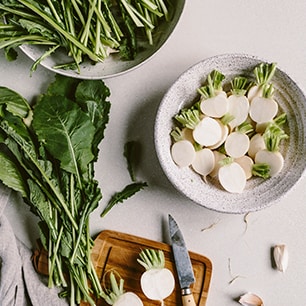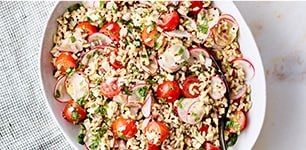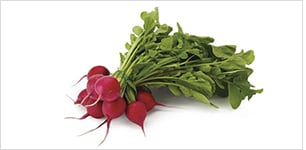You know that fruits and vegetables are essential to a balanced diet. But have you considered how many vitamins and nutrients go to waste when we discard parts of our produce during meal preparation? The USDA estimates food waste in the US at 30–40 percent of our food supply.1
Root-to-stem cooking—or fully using produce—is a great way to both minimize food waste and maximize nutrition and flavor. Let’s explore some simple ways to incorporate all the parts of vegetables into your cooking routine.

Make the Most of Your Produce
Our easy-to-implement tips and recipes can help you make the most of a variety of produce. Whether your family loves vegetables, or you need to devise a plan for sneaking them into your meals, we have plenty of ideas for you.
Stock Up
The notion of saving peels, stalks, tops, and skins to simmer in stock is nothing new, but it remains an excellent option for getting more out of your vegetables. Try these tips for making homemade stock that can add flavor and nutrients to your soup and other dishes.2
- Collect extra veggie pieces to store in the freezer, building up your supply for a savory stock.
- Save the often-discarded parts such as carrot tops, the green leaves of leeks, cores of cabbage and cauliflower, and more. Avoid beets, as they will redden the stock.
- The vegetable-to-water ratio for stock can vary, but in general you should use 2 parts water to 1 part vegetables.
- Simply combine vegetables, water, garlic, and herbs. Simmer for an hour and strain for a flavorful stock to use in soups and recipes.
Greens for Good
Don’t forget about the stems of your greens—from Swiss chard to kale to collards.3
- Chop and sauté them for a delightful crunch that offsets the texture of wilted leaves.
- Use stems in this Rustic Pasta and Salmon Sauté dish.
- Save them for your stock.
Beet and Greet
Roast beet roots in the oven to bring out their natural sweetness. And don’t forget about beet greens. Add them to our Creamed Skillet Greens with Mushrooms recipe or other dishes that call for greens.3
Potato Skins
Potato peels contain fiber, among other beneficial nutrients. If your recipe calls for peeling potatoes, you have a few alternatives.3
- Wash them well and leave the skin on to get the full nutritional value.
- Oven-bake the peels with olive oil and seasonings for a crispy side or salad topper.
- Enjoy them in our Hearty Potato and Lentil Salad recipe.
- Save them for your stock.
Stalking Broccoli and Cauliflower
While most people are accustomed to eating broccoli and cauliflower florets, the stalks are also edible and may be incorporated into your meal in a variety of ways.4 First, remove the outer layer of broccoli or cauliflower stalks with a vegetable peeler (you can save the peels for your stock too). Then try these preparation ideas:3
- Cut them into small pieces and roast them with the florets.
- Shred or shave them into thin ribbons for your salad or slaw, or use them as “noodles.”
- Join the riced veggie trend. Use your food processor to create signature blends with broccoli and cauliflower stalks and other vegetables and fresh herbs.
Here’s a fulfilling meal with a side of roasted broccoli: Ginger Spice Turkey and Relish with Roasted Broccoli and Sweet Potato-Apple Sauté.
This dish features cauliflower rice: Spiced Salmon with Mango Salsa and Cauliflower "Rice."
Don’t forget the leaves! Broccoli and cauliflower leaves are yummy in salads or sautés.2
The Whole Celery
Every part of celery is edible. Chop and include all of the stalks, inner and outer, in a variety of recipes. Use a peeler to make them less stringy if you prefer. Celery leaves are great in soups and salads or as garnishes.3
For your next cookout or gathering, bring along this light, refreshing salad featuring celery and apples: Crunchy Cranberry Waldorf Salad.
Carrot Tops
While carrots with their greens still attached are not as common as they used to be, carrot tops can add depth and character to dishes.5 They can also replace cilantro or parsley in a pinch. Publix offers organic carrots with tops.
Be sure to separate the tops and bottoms and store them separately, as the carrot greens drain moisture from the roots.5 Some people are sensitive to carrot greens, so start with a small amount. Blanching them first may improve the flavor.3
Our Roasted Carrots with Creamy Pesto recipe delivers a true root-to-stem experience.
Radish Redux
These tasty red gems are perfect sliced into salads. For even more flavor, pick up fresh radishes with the greens intact and include the greens in your salad, or create a pesto or other sauce with them.3 Be sure to try our Radish and Grains Salad recipe.
Leek News
These versatile veggies are relatives of onions and garlic, with milder flavor. They may be used in soups, eaten raw in salads, sautéed to perfect tenderness, braised soft and sweet, or chargrilled. While most recipes with leeks call for cutting off their green leaves, they’re too delicious to discard. Cook them with the rest of the leeks, or add them to your stock.3
Use the whole leek in our Potato-Leek Soup with Avocado.
Herb-a-licious Flavor
When it comes to fresh herbs, you can save the stems for all sorts of possibilities. They can enhance flavor in everything from soups and stocks to vinaigrettes and sauces.4
Herb stems are perfect for these recipes:
Just Juice It
Juicing is another great way to make use of fruits and vegetables from root to stem—and experiment with new produce. It extracts the juice from fresh produce, creating a liquid that contains most of the vitamins and minerals in the whole fruit. However, the fiber may be lost during juicing, so it’s best not to rely solely on juicing for your fruit and vegetable intake.
Here are a few juicing tips:
- Be mindful of the amount of fruits you put into your juice, as they contribute to your total sugar intake.
- Add vitamins and minerals to your juice without the sugar by using vegetables such as kale, spinach, and carrots.
- Use herbs or spices to enhance the flavor of your juice.
- Keep your portion size at 8–12 ounces to keep calories in check.
When you make use of the whole vegetable or fruit, you reduce waste—plus, you can gain the full nutritional benefits and complete range of flavors of these marvelous foods.
Reducing Food Waste
Since 2011, Publix has donated more than 337 million pounds of food to the Feeding America® network. Check out what else Publix is doing to reduce waste and increase sustainability.
For the Love of You
Choosing how you eat is uniquely personal. It’s about your needs, your preferences, and your goals. As your wellness ally, Publix is in your corner with fresh ideas, recipes, and wellness icons that make it easier to shift toward wiser food choices. It’s all about you, at your very best.
Sources
1 United States Department of Agriculture (USDA). “Food Loss and Waste.” USDA.gov. Accessed January 7, 2019.
2 Carlson, Elana. “Eat All Your Vegetables: How to Use Stems and Roots.” Food52.com. January 27, 2015.
3 Parsons, Rhea. “Cooking With Vegetables From Root to Stem.” OneGreenPlanet.org. Accessed January 7, 2019.
4 Vigoreaux, Gabriella. “Waste Not, Want Not: An Intro To Whole Vegetable Cooking.” Epicurious.com. September 30, 2014.
5 "5 Vegetables You Can Eat Root to Stem." GatewayGreening.org. July 8, 2015.

 You are about to leave publix.com and enter the Instacart site that they operate and control. Publix’s delivery and curbside pickup item prices are higher than item prices in physical store locations. Prices are based on data collected in store and are subject to delays and errors. Fees, tips & taxes may apply. Subject to terms & availability. Publix Liquors orders cannot be combined with grocery delivery. Drink Responsibly. Be 21. For prescription delivery, log in to your pharmacy account by using the Publix Pharmacy app or visiting
You are about to leave publix.com and enter the Instacart site that they operate and control. Publix’s delivery and curbside pickup item prices are higher than item prices in physical store locations. Prices are based on data collected in store and are subject to delays and errors. Fees, tips & taxes may apply. Subject to terms & availability. Publix Liquors orders cannot be combined with grocery delivery. Drink Responsibly. Be 21. For prescription delivery, log in to your pharmacy account by using the Publix Pharmacy app or visiting 

